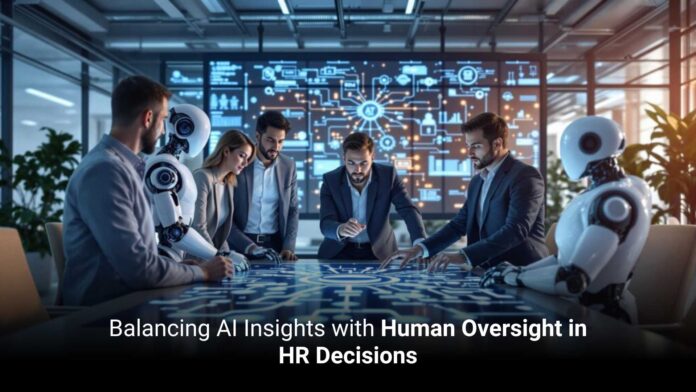A talent acquisition platform uses AI insights to screen job applications. The system predicts top candidates based on experience, skill alignment, and personality fitness. But here’s the twist: an exceptional candidate who took a career break for caregiving gets filtered out because the algorithm failed to understand the experience. This scenario explains why you need to balance AI insights with human oversight.
The need to balance lies in creating a partnership where AI supports decision-making. By integrating AI insights with human oversight, you can uphold fairness and inclusivity. Employees feel valued, which leads to better productivity and engagement.
This article will talk about the importance of balancing AI insights with human oversight.
Importance of AI in Transforming HR Decisions
Integrating AI in HR decisions helps in making better decisions relevant to the workforce.
- Data-Driven Talent Acquisition
AI has redefined how organizations identify and hire top talent. HR leverages AI insights to analyze candidate profiles, match job requirements, and predict cultural fit. For instance, a firm uses AI recruitment tools to screen and shortlist candidates based on skills and past performance data, reducing hiring time while improving the quality.
- Enhancing Employee Experience
AI personalizes employee journeys from onboarding to engagement. By analyzing communication patterns, survey feedback, and collaboration data, AI insights can detect a drop in morale or engagement early. For example, a company’s AI analytics within its HR ecosystem can identify departments with declining engagement scores and intervene.
- Predictive Retention and Workforce Planning
AI models can predict employee turnover by analyzing career progression, workload, and sentiment data. For instance, a firm leverages predictive AI to anticipate attrition trends, enabling HR to design retention strategies.
- Inclusive Performance Management
AI tools help eliminate bias in performance appraisals. By analyzing performance metrics, project outcomes, and peer feedback, AI ensures evaluations are based on the data. Firms employ AI to provide performance summaries, which help managers make decisions, leading to an equitable workplace culture.
- Learning and Development Optimization
AI personalizes employee learning paths based on skill gaps and role evolution. Platforms like LinkedIn Learning use AI insights to recommend training modules tailored to each employee’s growth needs. It aligns workforce skills with future business needs.
How to Balance AI Insights with Human Oversight in HR Decisions
Below are the steps to integrate AI insights with human oversight for HR decisions.
- Use AI as a Decision-Support System
AI can analyze and generate recommendations, but final decisions should remain human-led. For instance, they use AI screening tools to identify high-potential candidates, but recruiters make the final selection after one-on-one interviews.
- Human Validation of AI Recommendations
Every prediction, such as employee performance and retention risk, should be reviewed by a human. The analytics provide the projections, but HR should validate these signals through one-on-one discussions with employees. The blend ensures that decisions are both data-based and contextual.
- Continuous Monitoring and Feedback Loops
HR should regularly assess whether AI insights remain unbiased. For instance, an HR analytics team retrains its AI models using updated workforce data to reduce gender or role-based bias. Periodic audits and performance reviews of AI tools help to do the same.
- Empower HR with AI Literacy
Human oversight is effective only when HR understands how AI works. Organizations must invest in AI literacy programs to help interpret the insights. For example, a company runs internal training programs to help HR managers understand algorithm recommendations before acting on them.
- Maintain Empathy and Connection
Algorithms can’t measure motivation or emotions. HR leaders must prioritize empathy alongside efficiency. When AI insights suggest corrective action or concerns, HR should engage in conversations with the employees.
Impact of Balancing AI Insights with Human Oversight in HR Decisions
Balancing insights with oversight results in HR decisions that benefit the workforce.
- Improved Decision Accuracy
When AI insights are paired with human oversight, decisions are fair. AI can identify patterns or predict risks, but HR interprets the “why” behind those numbers. For example, AI forecasts employee turnover, but HR designs the final retention strategies.
- Enhanced Trust
Employees will trust HR decisions when they know humans have reviewed the decisions. Communicate how AI insights support evaluations, with human having the final say. It strengthens trust in HR systems, fostering a culture where AI is an enhancer, not a threat.
- Ethical and Responsible HR Practices
Balancing AI with human judgment reduces the risk of data misuse. For instance, a company creates review committees to audit AI HR tools, ensuring ethical compliance and alignment with diversity. It makes the organization a responsible employer, which helps in maintaining brand reputation.
- Strategic Workforce Planning
Combining AI’s capabilities with human intuition enables adaptive workforce strategies. AI insights help forecast future skill needs, while HR aligns them with business goals. A firm can use AI for succession planning, but humans should assess the initiative.
- Increased Employee Retention and Engagement
While AI can flag early signs of disengagement or burnout, HR can interpret behavioral nuances through conversation. A firm, for example, uses AI to monitor collaboration data and then helps HR to initiate personalized wellness programs.
Conclusion
Balancing AI and human oversight enhance trust, while employees gain confidence knowing their data doesn’t define them, and leaders gain visibility into the dynamics.
AI should assist, and humans should interpret. Synergy is what will set the organizations apart. Invest in responsible AI governance, train your teams to interpret the outputs, and keep empathy in every decision. The organizations that master this balance will build workplaces that empower people and give technology its true purpose.
Paramita Patra is a content writer and strategist with over five years of experience in crafting articles, social media, and thought leadership content. Before content, she spent five years across BFSI and marketing agencies, giving her a blend of industry knowledge and audience-centric storytelling.
When she’s not researching market trends , you’ll find her travelling or reading a good book with strong coffee. She believes the best insights often come from stepping out, whether that’s 10,000 kilometers away or between the pages of a novel.







